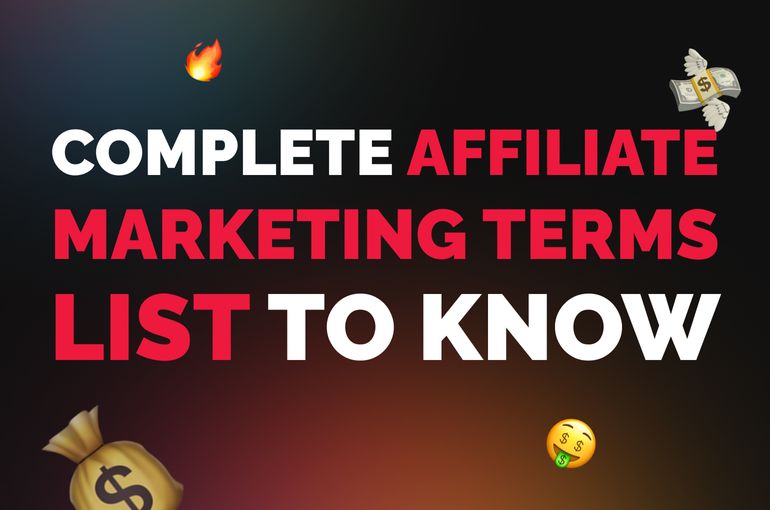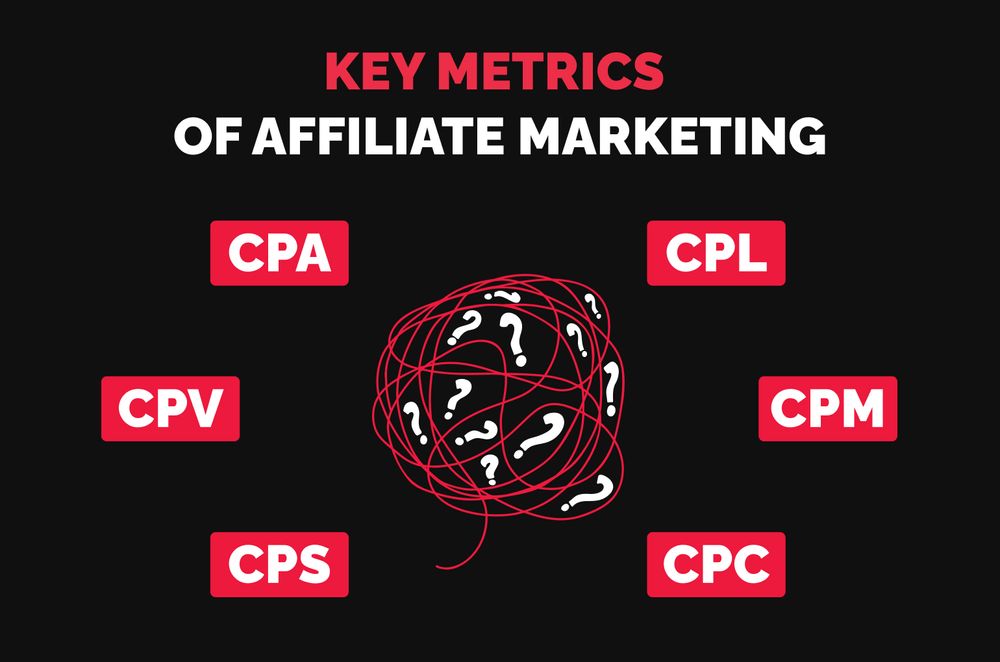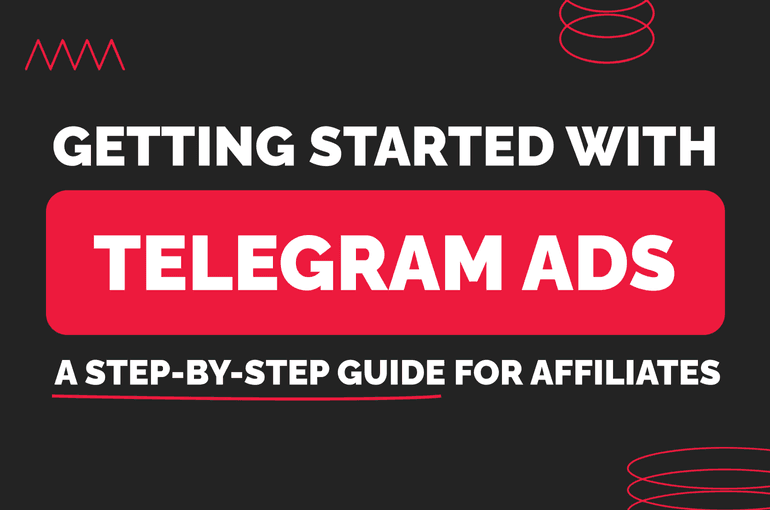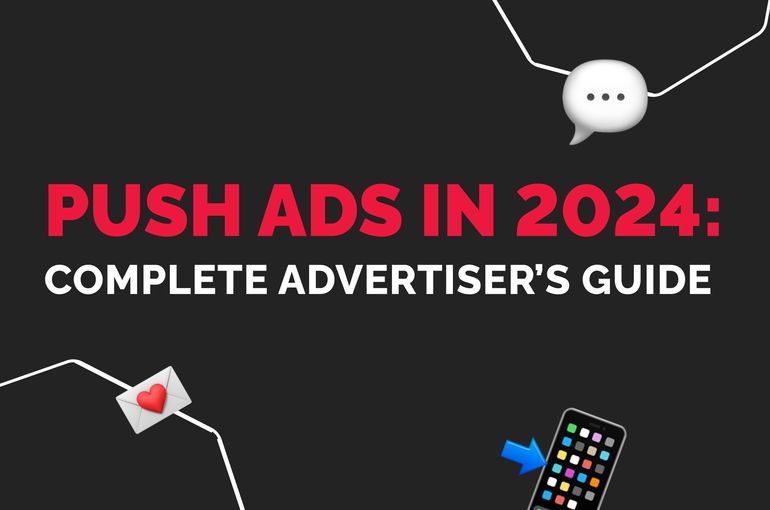Affiliate Marketing Glossary

Is the world of affiliate marketing new to you? You might already feel dizzy with all the terms and abbreviations. It's okay, we've all been there. At the same time, this knowledge would prove critical to anyone diving into marketing. So, we have compiled this essential affiliate marketing glossary to show you the ropes and kickstart your journey.
These explanations will give you a general idea of what each word means and how it relates to the domain of affiliate marketing. Equipped with this knowledge, you will feel more confident during professional conversations.
- Abbreviations
- Cost Per Action (CPA)
- Сost Per Click (CPC)
- Cost Per Lead (CPL)
- Cost Per Mile (CPM)
- Cost Per Sale (CPS)
- Cost Per View (CPV)
- Cost Per Completed View (CPCV)
- Online Behavioral Advertising (OBA)
- Pay Per Click (PPC)
- Pay Per Lead (PPL)
- RevShare
- Return On Investment (ROI)
- Return on Marketing Investment (ROMI)
- Earnings Per Click (EPC)
- Average Order Value (AOV)
- Lifetime Value (LTV)
- Return on Ad Spend (ROAS)
- Affiliate terms
- Affiliate
- Affiliate agreement
- Affiliate link
- Affiliate marketing
- Affiliate program
- Affiliate Marketing's Parties
- Affiliate network
- Advertiser
- Publisher (Affiliate marketer)
- Consumer
- Niche
- Traffic source
- Funnel
- Clickthrough rate (CTR)
- Conversion rate
- Commission
- Impression
- SEM
- SEO
- SERP
- Cookie
- First-party cookies
- Third-party cookies
- Click fraud
- Poor quality traffic
- Conclusion
Abbreviations
Let us begin our affiliate marketing glossary with an extensive list of marketing abbreviations.

Cost Per Action (CPA)
The cost per action model in affiliate marketing compensates affiliates for particular actions, such as form submissions or completed purchases. CPA marketing is used by businesses of all sizes to expand their marketing initiatives and extend their reach to a broader audience. A good example here is a partnership with an influencer or an advertiser who promotes your products and receives payment if the audience makes a purchase.
Сost Per Click (CPC)
Cost per click is a metric that determines the amount advertisers pay for placing ads on websites or social media, depending on the number of clicks a certain ad accumulates. Marketers must take CPC into account as it indicates the cost of a brand's paid advertising campaigns. Marketers aim to decrease the cost of clicks while fostering high-quality clicks, thereby ensuring satisfied customers.
Cost Per Lead (CPL)
Cost per lead is a metric to determine the price of acquiring a potential client. It can also be viewed as a pricing model where advertisers pay a predetermined price for each generated lead (a potential client or a buyer).
Cost Per Mile (CPM)
Cost per mile, also known as cost per thousand, is an advertising metric that represents the cost of one thousand views or impressions of an advertisement.
Cost Per Sale (CPS)
The cost per sale, also known as pay per sale, is a metric utilized by advertising teams to calculate the amount of money paid for each sale generated by a particular advertisement.
Cost Per View (CPV)
Cost per view is a pricing system for video advertisements that is determined by the number of views or interactions the ad gets.
Cost Per Completed View (CPCV)
Cost per completed view is a pricing model in which advertisers are charged only when a user watches an entire video ad. This approach enables advertisers to focus on attracting high-quality users with reduced financial risk.
Online Behavioral Advertising (OBA)
Online behavioral advertising enables advertisers and publishers to present highly customized ads and personalized marketing messages to users, leveraging insights derived from their web browsing behavior. This approach enables the advertisers to present the right products to the right audiences based on what types of products or content they have been browsing before.
Pay Per Click (PPC)
As cost per click is a metric used to determine the price of each click on the ad, pay per click is a pricing model in marketing in which advertisers pay for each click on one of their ads.
Pay Per Lead (PPL)
As mentioned in the cost per lead section above, pay per lead is a pricing system in online marketing where the affiliate receives payment for each lead generated that meets the criteria outlined in the agreement with the advertiser. The quality of the lead is assessed based on its likelihood of becoming a paying customer.
RevShare
RevShare is a combination of two words: "revenue" and "share." It represents a revenue model where advertisers distribute a percentage of their earnings to affiliates. The typical commission may vary from 1% to 75%, and in certain instances, it can even reach 90% on specific platforms.
Return On Investment (ROI)
ROI is the abbreviation for return on investment. This metric determines the amount of money the company generates after spending on certain value-added activities. This metric goes beyond the list of marketing terms as it pertains to different types of investments such as buying new production equipment, hiring new talent, developing new products, or marketing existing products. Any money generated directly from such investments would be counted as a return on investment.
Return on Marketing Investment (ROMI)
Return on marketing investment is the portion of profit attributed specifically to marketing efforts, divided by the amount of marketing expenses or risks. ROMI differs from other 'return-on-investment' metrics as marketing is a distinct type of investment.
Earnings Per Click (EPC)
Earnings per click (EPC) is a unique term in the affiliate marketing glossary that indicates the average revenue earned each time an individual clicks on your links. This metric can be compared to other metrics, such as cost per click, to see how effective the marketing efforts are.
Average Order Value (AOV)
The average order value represents the average customer spending per transaction. This is calculated by dividing the total revenue by the total number of orders. Let’s take a simple hypothetical scenario: if your revenue is $50,000 distributed across 1000 orders, your average order value is $50.
Lifetime Value (LTV)
Lifetime Value is a projection of the average revenue that a customer will generate over their entire lifespan as a client at your business. This is just a projection, so there is no guarantee each particular customer will spend that amount. The value assigned to a customer can significantly influence various business decisions, such as marketing budgeting, resource allocation, profitability assessment, and forecasting.
Return on Ad Spend (ROAS)
Return on ad spend is a marketing metric that assesses the revenue generated for every dollar spent on advertising. Through the calculation and monitoring of ROAS, you can analyze the efficacy of your advertising efforts.
Affiliate terms
To get deeper into the specifics of marketing, you will need a solid understanding of the core terms. Here are some of the most notable ones.
Affiliate
An individual or, sometimes, a business entity that promotes a product or service in return for a commission based on subsequent sales or leads. Affiliates are occasionally referred to as publishers or affiliate marketers.
Affiliate agreement
An agreement or a contract between an affiliate and a business that outlines the terms and conditions of their cooperation. This contract may encompass compensation rates for the order, performance objectives, conditions of termination, and all the other aspects of cooperation between two entities.
Affiliate link
An exclusive URL link issued to an affiliate for monitoring clicks and conversions on a company's website. This link enables the merchant to credit any sales or leads to the respective affiliate. Businesses can create such links using specific online referral software.
Affiliate marketing
Affiliate marketing is a marketing arrangement where affiliates earn a commission for every visit, sign-up, or sale they generate for a merchant. This type of cooperation enables businesses to delegate a portion of their marketing and sales activities to another individual or entity. A good example here is cooperation with bloggers, influencers, or affiliate marketing companies that are exclusively targeted at delivering such services to the business.
Affiliate program
Commonly referred to as referral programs, they serve as a means for brands to encourage individuals to promote their products through distinctive affiliate links.
Affiliate Marketing's Parties

A strong understanding of the core parties engaged in affiliate marketing is also critical for any aspiring marketing professional. Here are the main marketing terms to know:
Affiliate network
A platform that links merchants with affiliates, providing tracking and payment solutions for both entities.
Advertiser
A brand engaging in the promotion of its products through affiliate marketing, often referred to as a merchant.
Publisher (Affiliate marketer)
An alternative term for an affiliate, denoting their role in publishing or promoting content that incorporates affiliate links.
Consumer
An individual or a business entity that buys advertised products or services. Other Affiliate Marketing Terms There are many more marketing terms to know as it is a vast discipline. The affiliate marketing glossary does not end with basic terms, and it can be expanded depending on the industry, market niche, audience, and channels of communication.
Niche
A niche refers to a specialized topic or area that marketers concentrate on when promoting affiliate products or services. This specialization aids them in maintaining a focus on a particular target audience and creating content that speaks to their specific needs.
Traffic source
A traffic source encompasses any platform that directs potential customers to the affiliate site, blog, or social media page. Although having a website to channel traffic is advisable, numerous affiliates and bloggers also operate through their social media accounts.
Funnel
The affiliate marketing sales funnel outlines the trajectory that a customer follows when buying a product. This tool assists businesses in increasing product sales or capturing more leads. A funnel represents a buyer’s journey from the moment they first learn of the product to the moment they purchase and interact with the product.
Clickthrough rate (CTR)
In the context of affiliate marketing, CTR is defined as the ratio of users who clicked on a specified link to the total number of users who viewed the page, link, or banner. It serves as a metric to gauge the effectiveness of your marketing promotion.
Conversion rate
The conversion rate represents the percentage of visitors on your affiliates' landing pages who click on the call to action, subsequently leading to the product sales page. For instance, if 1,000 people see the ad and 100 click on it, the click-through rate would be 10%.
Commission
Marketers earn a commission for directing customers to companies where they complete purchases. The commission rates vary, ranging from less than 1% to 20% or even higher, depending on the product and the number of referrals.
Impression
An impression refers to the instances when a banner, text, link, or other promotional material is displayed to a webpage visitor. Impressions play an important role in marketing, indicating how many times the advertisement was requested from the server and viewed.
SEM
SEM stands for Search Engine Marketing, and unlike SEO (Search Engine Optimization), it includes all advertising campaigns available through search engines such as Google, Bing, Yahoo, and others.
SEO
SEO stands for search engine optimization. It is commonly used by marketers across all industries trying to get their web pages to the top of the user’s search list. The common practice here is to optimize the content on the web page in such a manner as to increase the chance of the user clicking on the intended website’s link. In terms of objectives, both SEO and affiliate marketing share a common goal: they are forms of digital marketing that seek to guide the right customers to the right place.
SERP
Search Engine Results Pages are the pages presented by search engines in response to a searcher's query. Achieving a higher ranking on the SERP generally leads to increased traffic directed to your site. Web pages at the top of the results page are more likely to get more traffic from the users.
Cookie
A cookie is a small file stored on the user's computer that identifies the visitors on a certain website. In the context of affiliate marketing, cookies are useful for monitoring affiliate referrals.
First-party cookies
First-party cookies are set by the website and are employed to monitor the user's activity as they navigate from one page to another. These cookies enable critical website functions such as authentication, maintenance of shopping cart information, management of website preferences, and login details.
Third-party cookies
Third-party cookies are not set by the website. Instead, they are set by another party, such as an advertiser. These cookies are employed to monitor your online activity and gather data about your interests. Subsequently, this information is sold to marketers who utilize it for targeted advertising.
Click fraud
Click fraud is a malicious activity that aims to deceive tracking systems within networks. In this scheme, when a user clicks through to the merchant's site and completes a purchase, the illegitimate cookie stuffer receives payment in the place of a legitimate affiliate.
Poor quality traffic
Poor quality traffic can result from utilizing PPC advertising directly to a landing page or engaging with 'paid to surf' traffic platforms. This type of traffic can also occur if the campaign attracts the wrong audiences. You might attract the leads to your website and generate enormous traffic, but it would not guarantee purchases. Still, poor quality traffic can be organic. But if you attract the wrong audiences, you will not sell your products.
Conclusion
There’s much to learn, many terms to memorize, and lots of processes to master, yet the results of this effort will be exciting and rewarding for those who persist. As the industry continues to grow and change, there will be more marketing terms to know. But for now, you have our ultimate affiliate marketing glossary of all the relevant terms. Keep it pinned in your browser just in case, explore more learning materials, and keep on pushing through your marketing journey.
Recommended Articles

Master Telegram Ads: A Comprehensive Guide for Affiliates

Push Ads in 2024: Complete Advertiser’s Guide

